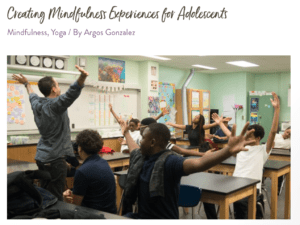As a high school teacher in the Bronx for 14 years I got to meet and deeply know a lot of teens. Having those relationships taught me a lot about what makes adolescents tick. I saw that the way adults view teens impacts the way teens see themselves, and ultimately the lives they think they are capable of leading. I also witnessed how school settings can be fertile ground for greater understanding and connection, or misunderstanding and miscommunication between teachers and young adults.
One of the high schools I worked at was a traditional school, with honors classes, Advanced Placement courses, Senior trips and proms. The other was a transfer school, where students go as a last chance for a high school degree (their prior schools failing to meet these students’ needs in one way or another). In this school students call teachers by their first name, they work closely with community based organizations, and it’s where I was lucky enough to introduce mindfulness.
Both schools were Title 1 schools, which meant the majority of the students were receiving free or reduced lunch. Both had committed, caring (and overworked) administrators, staff and teachers.
Since leaving the classroom I’ve gotten the opportunity to work with teens in more affluent communities (one of the schools a mere 10 miles north of the transfer school) where kids are getting the best education and resources their parents and communities can generously give. I wasn’t surprised to also see committed, caring, and overworked administrators, staff, and teachers but I was surprised to see how much these teens were also struggling.
Even though these adolescents’ educational contexts are very different, a couple of things are true for all of them. The adolescent years are challenging, confusing, and filled with changes to the body, their brain, and relationships. Adolescence is a tumultuous time of our lives!
Let’s also not forget about technology and the impact it’s having on our children. Most of us can probably remember what it was like to be bored when we were young and not have a screen readily available. Our parents would tell us to figure it out, go outside, go play. Or they would assign us a chore to make sure we didn’t stay bored. These moments of boredom often led to free play, which is critical in child development. According to the American Academy of Pediatrics free play helps children develop their imagination, curiosity, and healthy relationships with the children around them and their parents.
Whether we think the advent of technology is good or bad, it is here to stay and it is rewiring our children’s minds. Many have a harder time focusing their attention and developing relationships outside of their digital persona.
The Developing Brains of Adolescents
When I taught mindfulness to my teens in the Bronx, I often introduced the book Brainstorm by Dr. Daniel Siegel. Even though it was a challenging text for them to get through, they were engaged with the book because it was giving them insight into the way adults looked at them. It helped them understand what was changing in their brains and effecting the way they were feeling and acting. I will summarize some of the things I shared with my students here, but if this is a topic, you think would be helpful to you or your students will find interesting, make sure to add Brainstorm to your reading list.
Myths of Adolescence
The way we see adolescents becomes the way they see themselves. These misunderstandings can lead to confusion and conflict for teens and adults. Which of these myths are you familiar with?
1. Raging hormones cause teenagers to “go mad” or “lose their minds.”
According to Siegel hormones do increase, but these levels then stay consistent throughout much of adulthood. Its not the hormones that are causing behavior changes. What adolescents experience is primarily the result of natural and needed changes in their developing brains.
2. Teens are immature and need to grow up.
The risk-taking tendencies, impulsiveness, and high emotional sensitivity of teens is not a sign of immaturity but rather an outcome of exactly what they are supposed to be doing during this developmental stage—testing boundaries, creating their own view of the world, and preparing for life beyond the family home and school community.
3. Growing up requires moving from dependence on adults to total independence from them.
The healthy move to adulthood is toward interdependence, not complete do-it-yourself isolation. Giving care and receiving help from others is the model we should be supporting.
Pause, take a couple of breaths, and reflect on your own middle or high school experience. I’m sure you can understand why adolescents struggle during this time of their lives especially if the adults around them fundamentally misunderstand them. Remembering our own experience can help us be more understanding and compassionate in the interactions we have with teens.
To Continue Reading from Author Argos Gonzalez who is a teacher, lecturer, and mindfulness and yoga instructor please visit our partner “The Art of Living Retreat Center” @ https://artoflivingretreatcenter.org/blog/creating-mindfulness-experiences-for-adolescents/


